
My life goal is to create a future for myself where I can be as chill as my dog Moka. 😌
(JJ Abrams filter added for extra chill effect)

My life goal is to create a future for myself where I can be as chill as my dog Moka. 😌
(JJ Abrams filter added for extra chill effect)
In July I went to see a band called Daring Greatly. My friend Chris was doing sound at the event, and he was able to secure a photo pass for me. I hadn’t heard of the band before, but leading up to the event I listened to quite a bit of their music and was impressed. Live, they’re excellent, and put on a great show; flawless musicianship, powerful vocals, and on-point harmonies. I might not be a musician any more, but I can still recognize excellence when I hear it. 👂
It had been years since I did a live concert photo shoot, but it’s something I’ve always enjoyed. And so I got to work with my then month-old Nikon Z6 III, shooting about 1600 shots (and quite a few 6K videos, which I chose not to edit). After culling the photos down to 105 shots… ⬇️
I’m proud of a few of these shots; the frame rate of the Z6 III is incredible and it allowed me to capture moments that might have otherwise slipped by. The low-light performance is excellent, and when coupled with Lightroom Classic’s AI noise reduction, high ISO shots can be made to look like low ISO shots (mostly).
I also stretched my photographer persona by taking some crowd shots; sometimes that can go sideways if someone objects to having their picture taken. Obviously it helps having a badge around your next that shows you’re not just some random guy with a camera. 😜


(is that ⬆️ dude strong or what? 😯)
This is a drone flight over the community of Mahogany, a large residential suburb in Calgary, Alberta, Canada. The community has been under construction for years, and it was interesting to explore that from the air in July 2024.
They’ve completed a great deal of construction over the past two years, but there’s still so much to go. I don’t see construction like this where I live — pretty much everything is already built out — so I find it fascinating to watch the growth of new construction like this over time.
Maybe I’ll do another flight like this in 2030 and see how different it is.
Every year my family and I do a road trip back to Canada to visit our family and friends in the province of Alberta. We fly in the winter, but drive in the summer, as not only is a road trip a lot less expensive, I believe my children shouldn’t grow up not having experienced being stuck in a car for many hours at a time. 😆
The trip east, then north, takes about 12 hours with a couple of EV charging stops along the way. As we drive from our home city of Renton, Washington, we drive east on the I90. Once we come over the pass, the terrain starts to change.
It switches from lush forests to flat plains where farming occurs. And along that route is an area that I can only describe as “the badlands”: little to no vegetation, dry, arid land that is starkly beautiful. Last summer I finally stopped on the way back home to fly my drone around the area to capture some of that beauty after two years of saying “You know, this would make a great drone video”.
It reminds me a great deal of Drumheller, Alberta, a badlands area and the site of many dinosaur fossil finds.
I had the pleasure of experiencing my first Cirque du Soleil show in the state of Washington: Kooza! And I managed to take a few decent photos (and some video clips) with my Fujifilm X100VI.
The following is a lightly edited version of the most epic Thread I’ve ever posted…with the addition of that hilariously awesome Google Gemini-created image above.
After editing hundreds of photos from my recent work trips to Malaysia and Thailand (amazing countries! 🙌), all shot on my @googlepixel 9 Pro, I was reminded yet again that tiny smartphone camera sensors ultimately still kind of suck. 😕
Yes, they are computational marvels capable of amazing feats of HDR, but the image quality in anything but perfect light remains hot garbage. 🔥 🚮 I uttered the words “That would have been a great picture if it was taken on a real camera” many times. 😔 But on a work trip, taking my Nikon Z6 III is a non-starter. I try to travel carry-on and even at its smallest my beloved Z6 is a bulky beast.
I started researching options for the smallest camera that had a big sensor and met my other needs. The list was sadly short: the fujifilmx100vi and Panasonic S9. Many reviews and videos later, I decided I wanted the Fujifilm camera. The problem? It’s perhaps that most in-demand camera on the planet right now, with wait lists 6+ months long. 😢
I searched online in vain, looking at all the places I’d normally buy from (@bhphoto, Amazon, even eBay). It was either not in stock or selling for 30-50% above MSRP in “valuable bundles”. 🙄 I wanted the camera, but I didn’t want to pay a stupid amount for it.
Then I posted a silly rant to Fujifilm USA griping about their lack of stock. The Threads algorithm did its thing, and a helpful reply from John Cessna encouraged me to try local stores. I’d tried everything else, so why not? I’m in Alberta, Canada right now, so I went into Google Maps and started contacting local stores via web chat and phone. The web site of the third store, Saneal Camera, said they had one in stock. I thought it was an error, but I called anyway.
The guy on the phone said they did indeed have one. 😲 He’d updated the web site 10 minutes ago; a customer pre-ordered then backed out. I said I’d come and buy it right away. 50 minutes later, I had this beautiful box in my hands.

The form factor and image quality of the fujifilmx100vi make for a very compelling combination. How much smaller is the X100VI than my Nikon Z6 III? This photo says it all. I’m very excited about taking this camera with me on my next work trip.
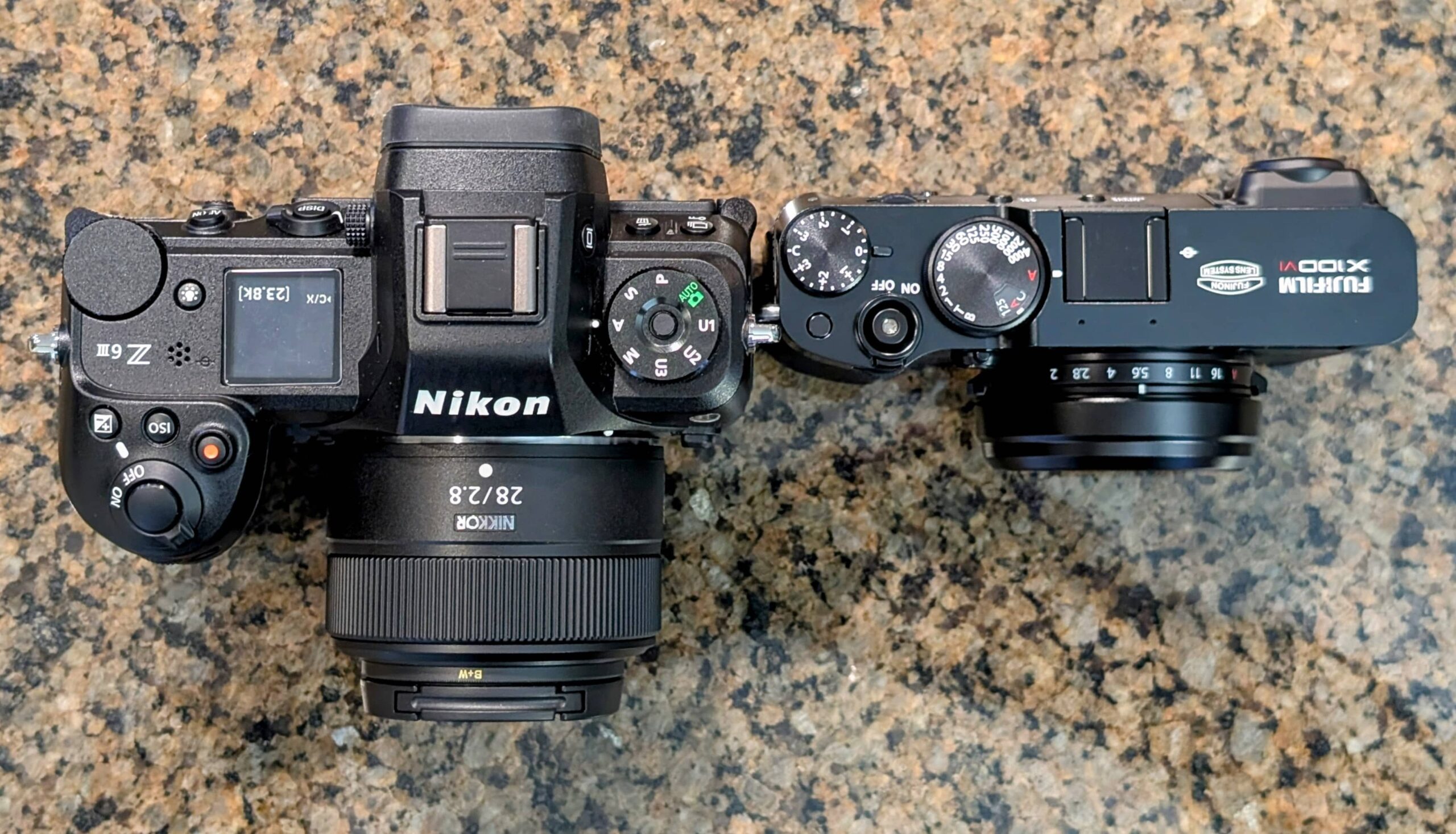
Here are a few pictures I snapped with the Fujifilm X100VI on a cold winter day in downtown High River, Alberta, Canada. 🇨🇦 Image editing done in Lightroom; I am still puzzling over whether I want to switch back to being a JPEG shooter and use in-camera LUTs, breaking free from the tyranny of raw post-production. 😂
A post for another day…
In 2018 I was in Las Vegas for an Adobe Summit — back when I was all trained up on Adobe’s suite of enterprise products — and I went to the Marvel Avengers S.T.A.T.I.O.N, a really cool interactive exhibit. I managed to get a picture of the War Machine prop armour, and because of the lighting it didn’t take much effort to black out the background entirely and turn it into a pretty cool device wallpaper.
Download War Machine wallpaper: 5K | 4K | 1080p | iPad Pro 13 | Pro 11
Earlier this year, I started noticing some very strange ads showing up in my Google phone feed. The ad copy and the images were odd at best, nonsensical at worst. The images and copy made zero sense together. I wish I’d captured more of them!
My working theory is that this was an early attempt at GenAI-based ad copy + image creation. It didn’t last very long, perhaps a few weeks, so either the technology got dramatically better, or they pulled the plug and re-introduced human curation of the ads. I suspect the latter. Either way, I did manage to capture these amusing examples, so enjoy GenAI Ads Gone Wild…






The image above is was created by Google’s Gemini AI tool on my Pixel 9 Pro. It’s mostly accurate except what is that thing in the lower right? 🤔
I’m not an exceptionally well-travelled person (I have a friend who has flown 60 times so far this year; I’m at 10% of that), but I’ve travelled more than some. I consider myself an intentional traveler; someone who thinks about and plans for the act of traveling. Each time I travel, I find it strangely enjoyable to look at what I use — everything from tech to cables to clothing — and figure out if there’s a way to pack less or pack smarter by bringing something different. Travel can be very stressful, so I try to not be like the guy in the image above. I control what I can control (my choices of what to pack, when to leave for the airport, etc.) and try to flow with the rest that I can’t control.
For a techie like me, keeping my electronics — MacBook Pro, iPad Pro 11, Pixel 9 Pro, Pixel Buds Pro 2, Kindle PaperWhite, and FitBit Charge 5 — powered up is critical. I was chatting with a friend about what each of us carries and the resulting messages to him were a good portion of this blog post. I figured why not share with the world?
One important point in understanding why I carry what I do is that I have a deep-seated need to never NOT have the right adapter/plug/solution to solve my own problem or help someone else. I was never a Boy Scout, but I do have an “always be prepared” mentality when it comes to technology and traveling.
It’s amusing to me that four of the six devices I travel with have “Pro” in the name — apparently, I need to seek out a “pro” e-book reader and watch!
Up until recently, my one and only charging solution was what today I have dubbed the Max Charging Pack (it needed a name for this blog post). A couple of trips ago I was on a flight, and it was packed in my carry-on suitcase. I wanted to charge my phone (I’d used it much more than normal) and I was irritated that I didn’t have my charging gear in my backpack — but I’d purposefully put the Max Charging Pack into my suitcase because it made my backpack much heavier. When I returned home, I decided to create a minimalist charging pack, something I could always have in my backpack. What’s the difference between the two? Let’s dive in…
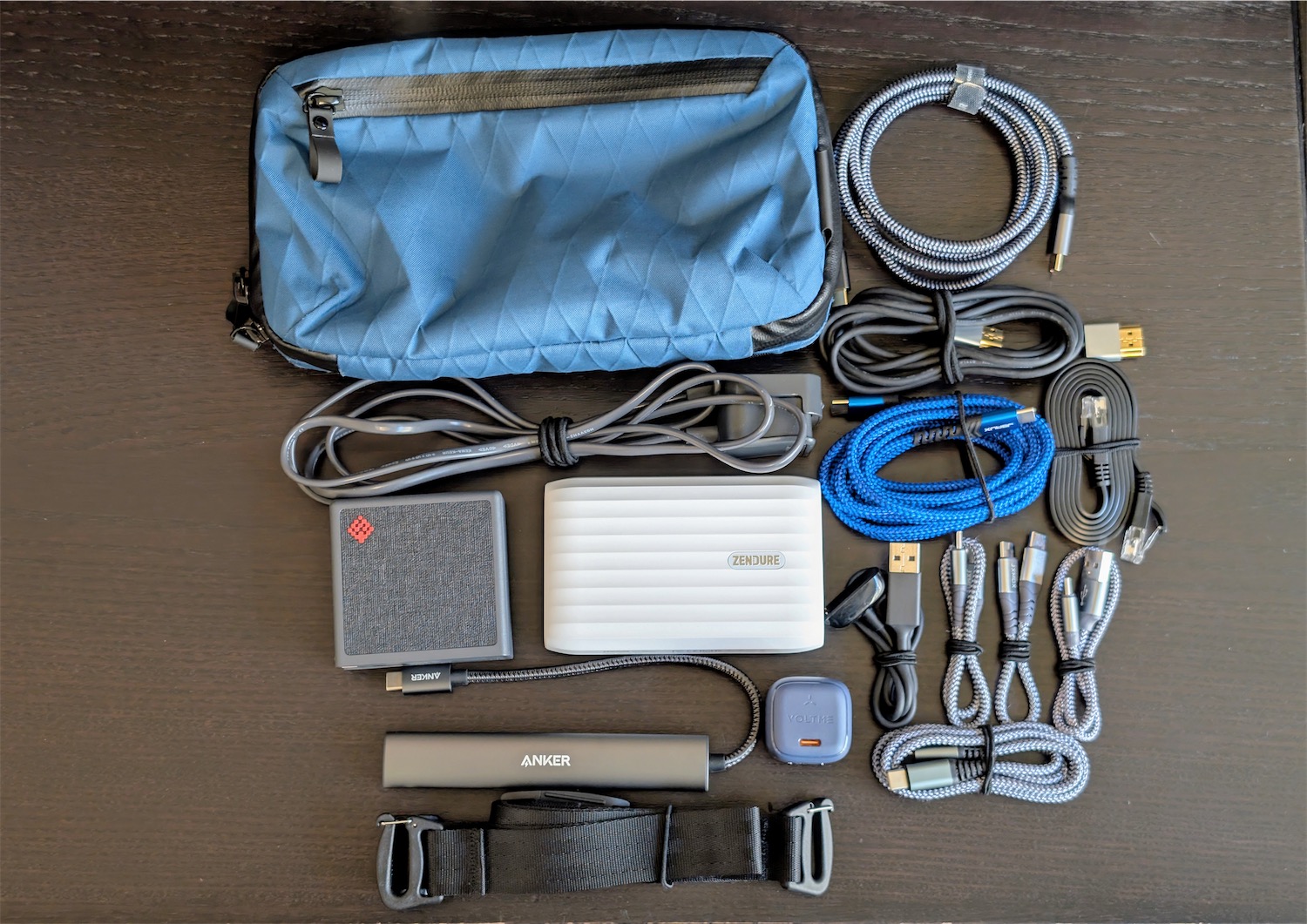
The SlimQ charger is really the star of the show here because it can be connected to a wall socket directly, or with an included cable that allows me to keep the charger up on the hotel desk/table and use short cables. It also has international heads that can be swapped out, though I have yet to use it internationally (which will change in November).
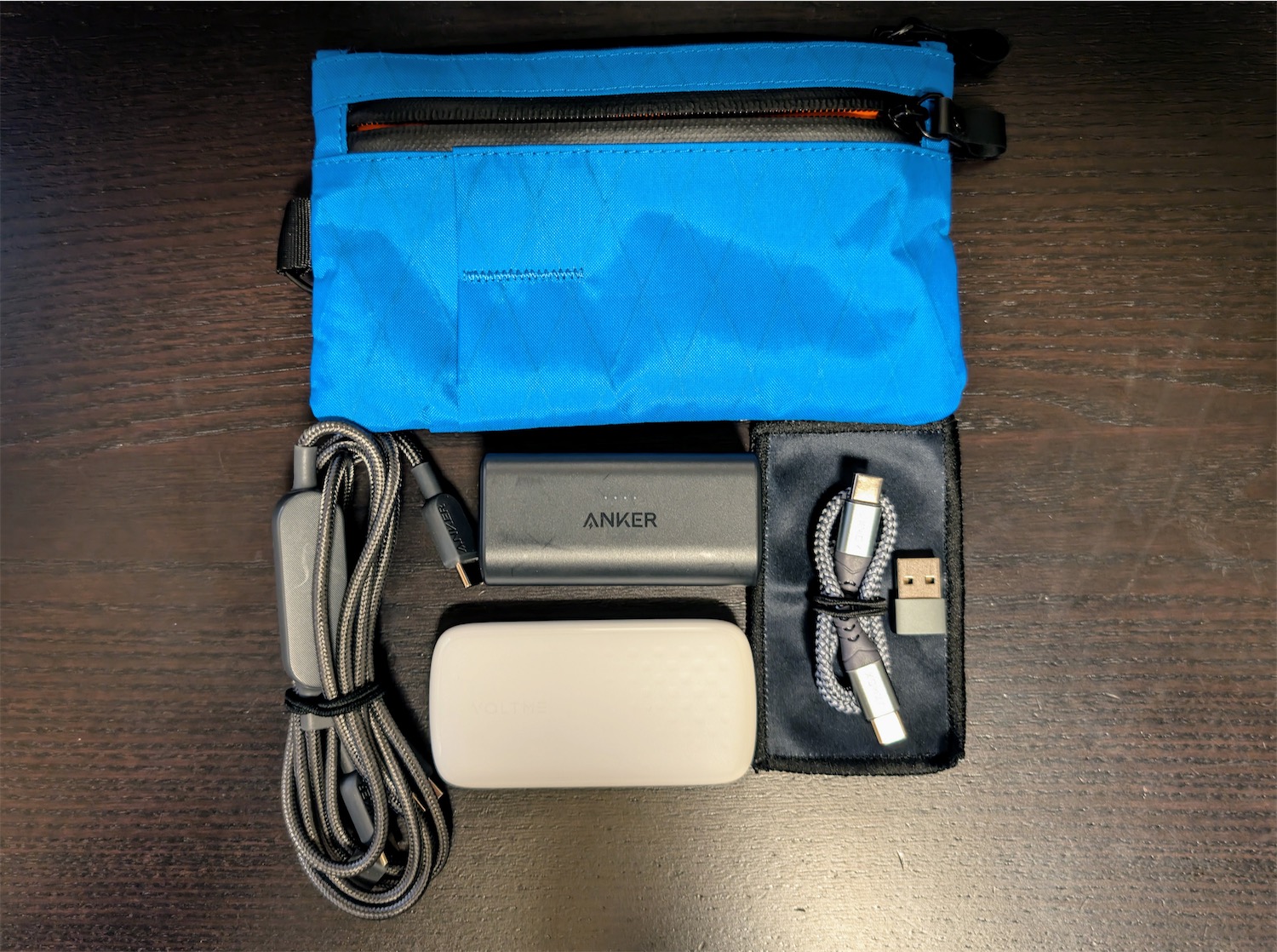
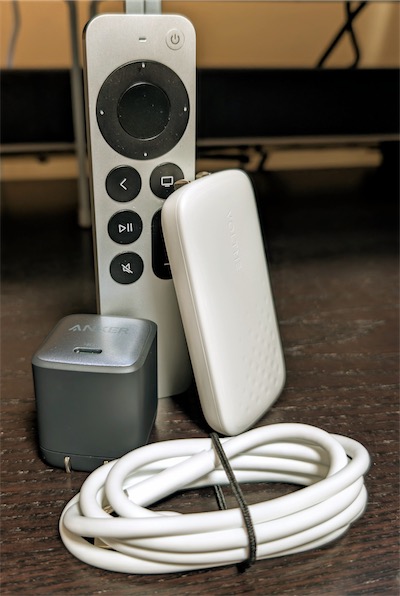
Everything fits nicely, as I place the Anker battery vertical, the Anker cable and VOLTME charger horizontally, and I have some room to spare. It was important to me that this pouch not get too thick and bulky. This configuration keeps the Zip Clutch fairly thin and it slips into the pouches in the backpacks I use (mainly the Alpaka Elements Travel Backpack, or the Alpaka Metro Backpack for office trips).
Image: on the left, my old Anker 45W adaptor replaced now by the 65W VOLTME Slimline on the right.
Additionally, because the Alpaka Zip Clutch has a decent-sized front pouch, it works well to carry all my small to medium-sized adaptors. So that’s a CF Express Type B card reader (for my Nikon Z6 III), an SD/microSD card reader, a SIM card ejector (though in this era of eSIMS, increasingly not needed), microSD to SD adaptor, a small USB-C adaptor I put on the end of a USB-C cable to see wattage levels, and a variety of any-port-to-USB-C adaptors. Many of these I carry just in case someone around me needs to connect an older device.
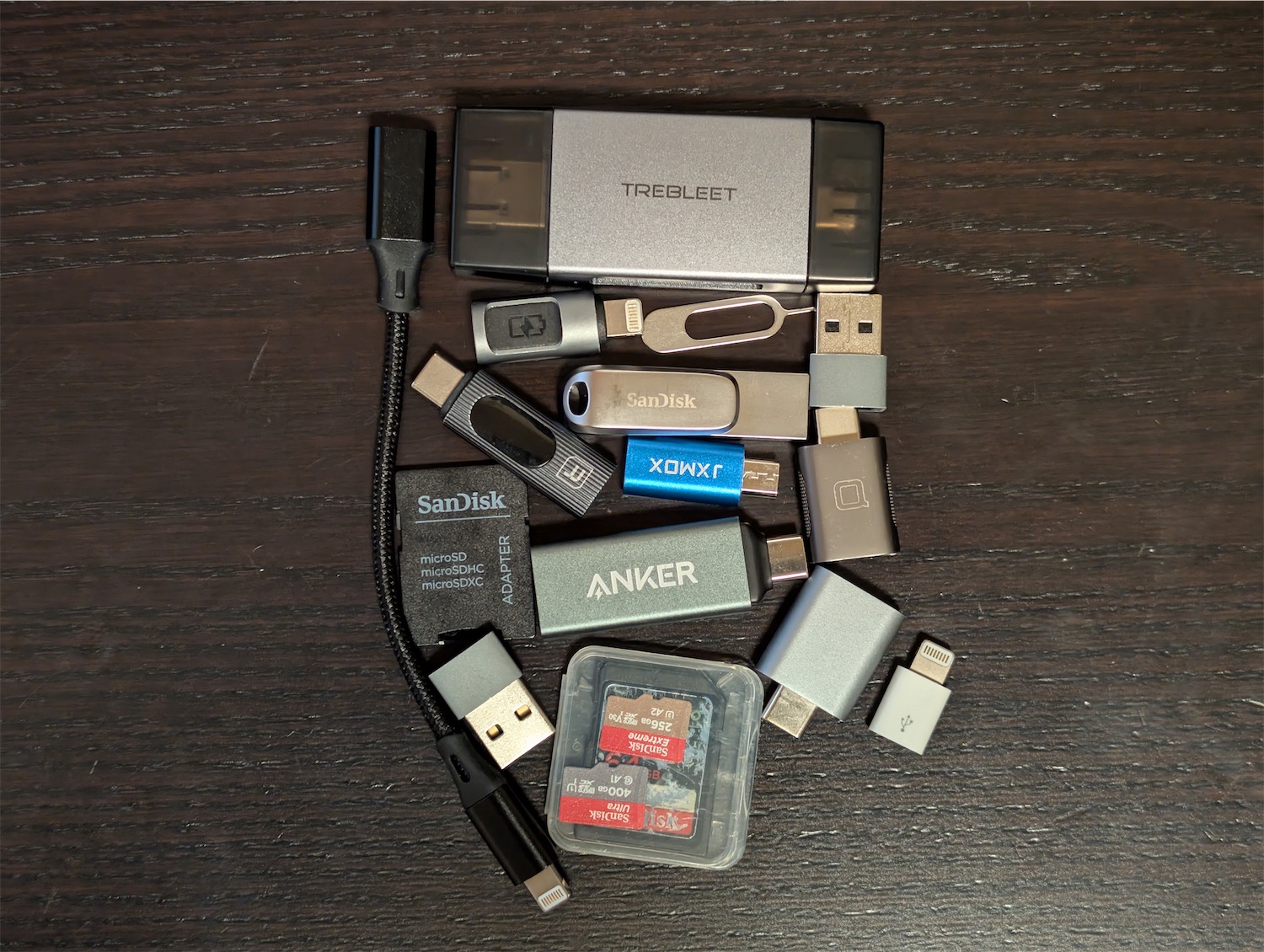
I also carry a variety of flash storage: a 512 GB flash drive, 400GB and 256GB microSD, and a 64 GB SD. The former for file movement, the latter for extra device storage (my drone). I can’t remember the last time I had to use these storage devices, but better to have them than not (seeing a theme here? 😂).
I tend to keep the big charging pack in my carry-on suitcase, and the mini pack in my backpack. I’ve discovered I am much happier pulling weight than having it on my back. 😄 So the max goes into the suitcase, usually a carry-on, but sometimes checked if it’s a family trip and we carry a big, checked bag.
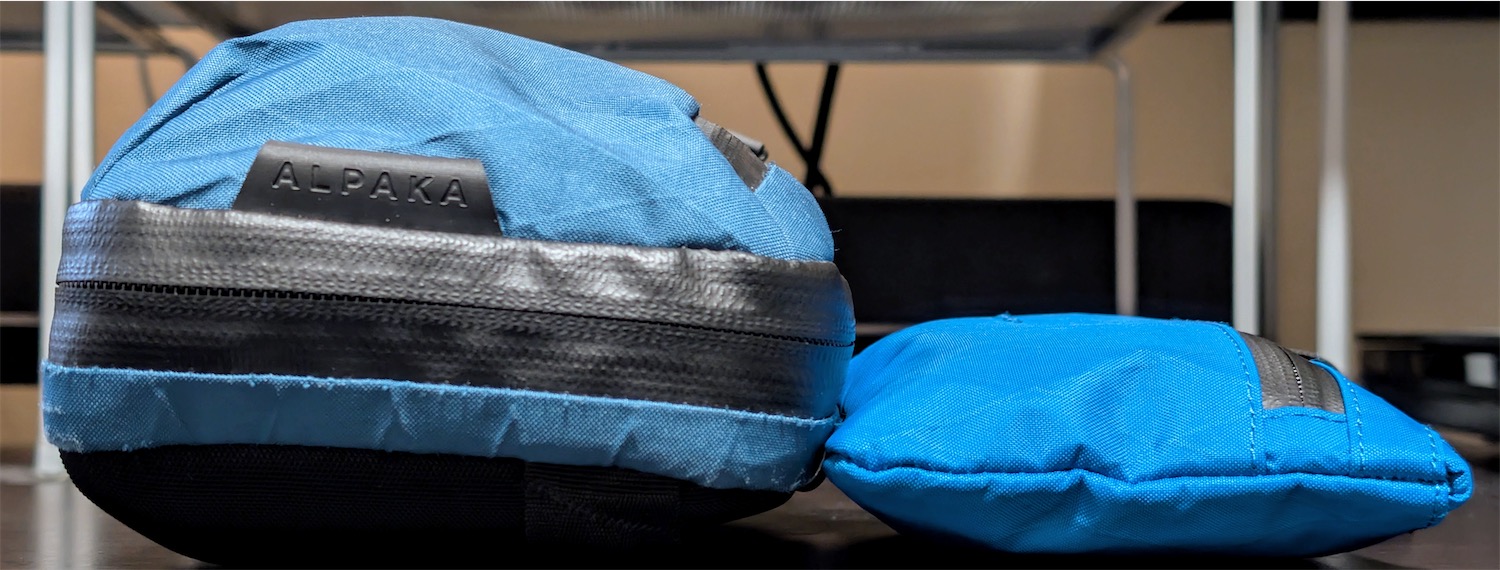
As GaN chargers have proliferated over the past few years, chargers have gotten smaller and smaller, which is amazing for travel. They’ve even managed to increase the wattage without making them huge. This has led to a “wattage war” where every year the major players try to out-do each other with more watts. Currently that seems to be 140 watts, which frankly is overkill unless you are charging two laptops simultaneously and you need to charge them quickly.
Most people don’t really understand how devices top out in their ability to accept incoming power. I’m fond of cables and adaptors that tell me how much power a device is using to charge, and it’s less than you’d guess. My MacBook Pro 14 tops out at 96 watts, and that’s only when it’s extremely low on power. Usually, it charges at about 50 watts or less. If it’s got a nearly full battery, I can work on it all day while connected to a 30-watt charger and it will remain at full charge. My iPad Pro 11? 34 watts, then ramps down to 10 watts or less as it gets close to full. My Pixel 9 Pro? 27 watts max, then down to under 5 watts.
I’ve considered carrying a few of the $10 VOLTEME 30-watt cube chargers to give to people who I see at airports charging their iPhones or iPads from the old 5-watt charger, which, when you’re looking for a quick charge, is almost useless unless you’ve got an hour to spare. I’ve yet to do this because random generosity could be taken the wrong way, and they might not have a USB-C iPhone/iPad. But I still think about it as I watch people charge oh-so-slowly. 🫠
I’ve been trying to be thoughtful about how much wattage I really need and that has changed how I think about charging. On two recent trips, I brought the Max Charging Pack with me, yet left it in my suitcase, using only the Mini Charging Pack and guess what? It did everything I need, even with the previous version of my pack topping out at 30 watts with the VOLTME. I have yet to travel with the 65-watt VOLTME, but it will do all I need for solo travel.
I don’t know if I’ll ever truly be “done” optimizing my tech charging gear, but this recent iteration feels like it’s about as good as it’s going to get barring new breakthroughs in GaN charging. I’ll never say no to smaller, but I will say no to anything that offers more power than I will realistically use. I have my first international trip with this new charging gear coming up in November, so I’ll see if my choices allow me to continue being a relaxed traveler. Stay tuned. 😉
18 years ago, I went on a Hawaiin cruise with Ashley, and would you believe I still have some scans of memories from that trip I have yet to do anything with? I’d originally planned on doing a vacation book, but after 18 years I think it’s time I admit that project isn’t going to happen any time soon. 😂
What I did find though are two files that I scanned and meant to share as part of my Object Collection. They are one side of a Maui Trade Dollar (why didn’t I scan the other side? No idea.) And one ship room key.


Be sure to check out the whole Object Collection category to find more scanned objects. These objects are free for personal use, but commercial use is prohibited without permission. Please see my Creative Commons License for further usage details.